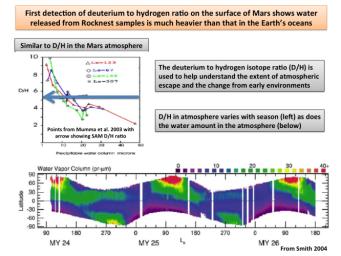
|
Atmospheric Loss on Mars
- Click the image above for a larger view
- Full-Res JPEG (1600 x 1200) (216.4 kB)
- Full-Res TIFF (1600 x 1200) (5.8 MB)
Caption:
This plot shows the first-ever look at the deuterium to hydrogen ratio measured from the surface of Mars, as detected by the Sample Analysis at Mars instrument, or SAM, on NASA's Curiosity rover. Deuterium is a heavier version of the hydrogen atom. Scientists look at the deuterium to hydrogen ratios on Mars (or D/H levels) along with isotopes of other elements to study how its atmosphere has changed over time. Mars, which has less gravity than Earth and lacks a strong enough magnetic field to shield its atmosphere from the sun, is slowly losing its atmosphere. As this process occurs, the lighter hydrogen atoms are preferentially lost compared to the heavier deuterium ones.
SAM measured the D/H ratios in water released upon heating of sand samples taken from the wind drift called "Rocknest." The results show the water vapor consists of more deuterium than that of Earth's water, i.e. the water is heavier. This is to be expected since the lighter hydrogen atoms in the Martian atmosphere are escaping faster than the heavier ones.
Background Info:
JPL manages the Mars Science Laboratory/Curiosity for NASA's Science Mission Directorate in Washington. The rover was designed, developed and assembled at JPL, a division of the California Institute of Technology in Pasadena.
For more about NASA's Curiosity mission, visit: http://www.jpl.nasa.gov/msl , http://www.nasa.gov/mars , and http://mars.jpl.nasa.gov/msl .
Cataloging Keywords:
| Name | Value | Additional Values |
|---|---|---|
| Target | Mars | |
| System | ||
| Target Type | Planet | |
| Mission | Mars Science Laboratory (MSL) | |
| Instrument Host | Curiosity Rover | |
| Host Type | Rover | |
| Instrument | Sample Analysis at Mars (SAM) | |
| Detector | ||
| Extra Keywords | Atmosphere, Color, Magnetosphere, Water | |
| Acquisition Date | ||
| Release Date | 2012-12-03 | |
| Date in Caption | ||
| Image Credit | NASA/JPL-Caltech/GSFC | |
| Source | photojournal.jpl.nasa.gov/catalog/PIA16574 | |
| Identifier | PIA16574 | |
